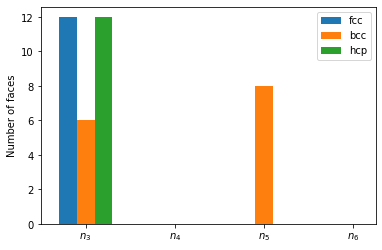Voronoi parameters¶
Voronoi tessellation can be used to identify local structure by counting the number of faces of the Voronoi polyhedra of an atom. For each atom a vector \(\langle n3~n4~n5~n6\) can be calculated where \(n_3\) is the number of Voronoi faces of the associated Voronoi polyhedron with three vertices, \(n_4\) is with four vertices and so on. Each perfect crystal structure such as a signature vector, for example, bcc can be identified by \(\langle 0~6~0~8 \rangle\) and fcc can be identified using \(\langle 0~12~0~0 \rangle\). It is also a useful tool for identifying icosahedral structure which has the fingerprint \(\langle 0~0~12~0 \rangle\).
import pyscal.core as pc
import pyscal.crystal_structures as pcs
import matplotlib.pyplot as plt
import numpy as np
The crystal_structures module is used to create
different perfect crystal structures. The created atoms and simulation
box is then assigned to a System object. For
this example, fcc, bcc, hcp and diamond structures are created.
fcc_atoms, fcc_box = pcs.make_crystal('fcc', lattice_constant=4, repetitions=[4,4,4])
fcc = pc.System()
fcc.atoms = fcc_atoms
fcc.box = fcc_box
bcc_atoms, bcc_box = pcs.make_crystal('bcc', lattice_constant=4, repetitions=[4,4,4])
bcc = pc.System()
bcc.atoms = bcc_atoms
bcc.box = bcc_box
hcp_atoms, hcp_box = pcs.make_crystal('hcp', lattice_constant=4, repetitions=[4,4,4])
hcp = pc.System()
hcp.atoms = hcp_atoms
hcp.box = hcp_box
Before calculating the Voronoi polyhedron, the neighbors for each atom need to be found using Voronoi method.
fcc.find_neighbors(method='voronoi')
bcc.find_neighbors(method='voronoi')
hcp.find_neighbors(method='voronoi')
Now, Voronoi vector can be calculated
fcc.calculate_vorovector()
bcc.calculate_vorovector()
hcp.calculate_vorovector()
The calculated parameters for each atom can be accessed using the
vorovector attribute.
fcc_atoms = fcc.atoms
bcc_atoms = bcc.atoms
hcp_atoms = hcp.atoms
fcc_atoms[10].vorovector
[0, 12, 0, 0]
As expected, fcc structure exhibits 12 faces with four vertices each. For a single atom, the difference in the Voronoi fingerprint is shown below
fig, ax = plt.subplots()
ax.bar(np.array(range(4))-0.2, fcc_atoms[10].vorovector, width=0.2, label="fcc")
ax.bar(np.array(range(4)), bcc_atoms[10].vorovector, width=0.2, label="bcc")
ax.bar(np.array(range(4))+0.2, hcp_atoms[10].vorovector, width=0.2, label="hcp")
ax.set_xticks([1,2,3,4])
ax.set_xlim(0.5, 4.25)
ax.set_xticklabels(['$n_3$', '$n_4$', '$n_5$', '$n_6$'])
ax.set_ylabel("Number of faces")
ax.legend()

The difference in Voronoi fingerprint for bcc and the closed packed structures is clearly visible. Voronoi tessellation, however, is incapable of distinction between fcc and hcp structures.